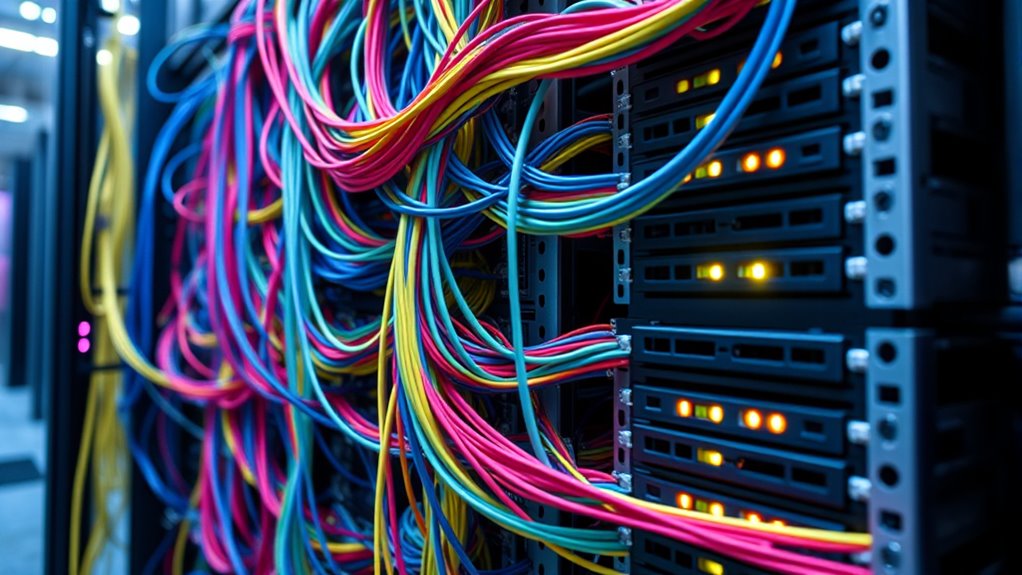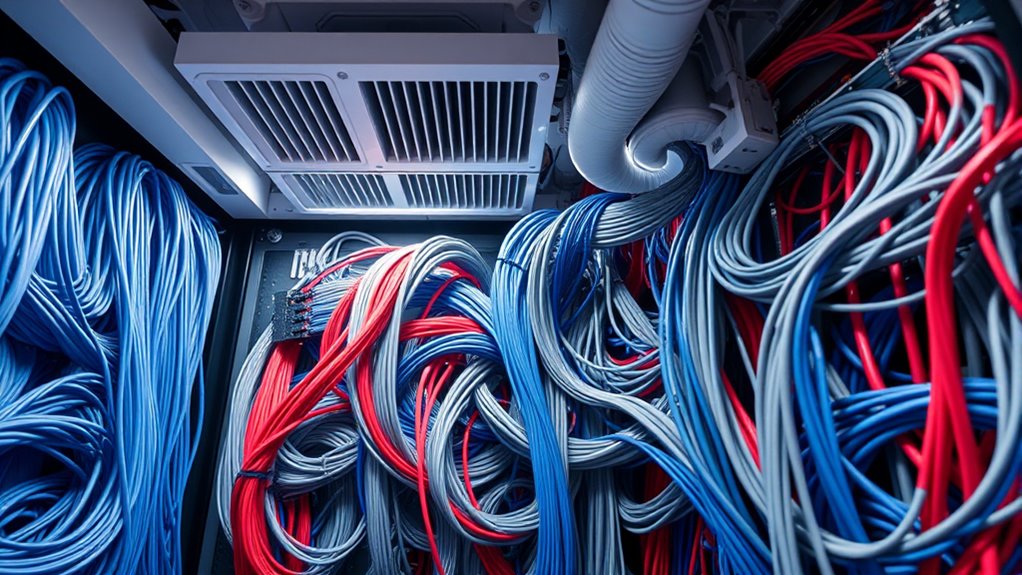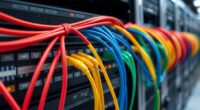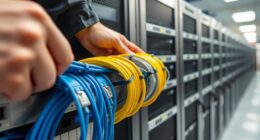Managing dense cabling is like balancing a delicate ecosystem—you must keep airflow flowing smoothly to prevent hotspots and equipment failure. Proper organization, clear pathways, and strategic placement of cooling elements are essential. Without careful planning, turbulence and temperature spikes can threaten system stability. Curious about how to design an efficient cooling environment that keeps everything running at ideal temperatures? Let’s explore the key considerations to achieve that balance.
Key Takeaways
- Plan cable layouts to prevent airflow obstruction and ensure proper spacing for efficient cooling.
- Use hot aisle/cold aisle containment to segregate hot exhaust air from cool intake air.
- Install temperature sensors to monitor hotspots and adjust cooling strategies proactively.
- Incorporate intelligent cooling systems that automate airflow and fan speed adjustments based on load.
- Maintain organized cabling to reduce turbulence, facilitate airflow, and support effective heat dissipation.

As data centers become more densely packed with cables, effective cooling becomes crucial to prevent overheating and guarantee reliable performance. When cabling density increases, airflow optimization becomes essential to ensure cool air reaches every component and hot air is efficiently expelled. You need to carefully plan the layout of your cables to avoid obstructing air pathways. Proper spacing between cables allows for better airflow, reducing the risk of hotspots that can impair hardware. You should also consider vertical and horizontal cable management strategies, such as cable trays and ducts, to maintain consistent airflow channels. This minimizes turbulence and stagnant air pockets, which can trap heat and cause equipment failures. Utilizing HEPA filters in your cooling systems can also help reduce airborne contaminants that might further impact hardware performance. Implementing heat dissipation techniques is equally important. You can deploy advanced cooling solutions like hot aisle/cold aisle containment, which segregates hot exhaust air from cool intake air. This targeted approach helps maintain ideal temperature zones and improves overall cooling efficiency. Pairing containment with high-capacity cooling units ensures that hot air doesn’t recirculate within the data center, keeping temperatures within safe limits. Additionally, using perforated tiles or floors allows cool air to be directed precisely where it’s needed, preventing uneven cooling that can lead to equipment strain. You should also consider the placement of your cooling hardware. Positioning exhaust fans and vents strategically in relation to densely cabled areas can greatly enhance heat dissipation. For example, placing exhaust fans near hot spots or high-density zones helps draw out excess heat more effectively. Regularly monitoring temperature sensors throughout your data center provides real-time insights into airflow effectiveness and heat dissipation performance. This data enables you to make informed adjustments, improving cooling efficiency and preventing potential failures. Moreover, integrating intelligent cooling management systems can automate airflow adjustments based on load and temperature variations. These systems optimize fan speeds and cooling distribution dynamically, reducing energy consumption while maintaining safe operating temperatures. Combining these methods with good cable organization not only improves airflow but also simplifies maintenance tasks, making it easier to identify and resolve cooling issues quickly.
Frequently Asked Questions
How Does Cable Material Impact Cooling Efficiency?
Cable material impacts cooling efficiency through its insulation and conductivity. You’ll find that cables with high material conductivity, like copper, allow heat to dissipate more effectively, preventing overheating. Conversely, those with better insulation reduce heat transfer, which can trap heat and hinder cooling. Choosing the right cable material guarantees ideal thermal management, helping your dense cabling setup stay cool and operate efficiently.
Are There Specific Cable Arrangements That Reduce Heat Buildup?
Yes, you can reduce heat buildup by implementing proper cable arrangements. Use ventilation strategies like open racks or cable trays to promote airflow and prevent heat accumulation. Avoid tight cable bundling, as it restricts airflow and increases temperature. Instead, space out cables adequately, incorporate airflow gaps, and organize them neatly to enhance cooling efficiency. These steps help maintain ideal temperatures and prolong the lifespan of your cabling system.
What Monitoring Tools Are Best for Detecting Cable Overheating?
You need to stay ahead of overheating risks, so consider thermal sensors and infrared cameras as your best tools. Thermal sensors provide real-time temperature data, alerting you before issues escalate. Infrared cameras let you visually scan your cabling, revealing hot spots instantly. These monitoring tools are essential for proactive cooling, ensuring your dense cabling stays safe and operational. Don’t wait—detect threats early and keep your system cool under pressure.
How Often Should Dense Cabling Systems Be Inspected for Cooling Issues?
You should inspect your dense cabling systems at least quarterly to guarantee ideal thermal management and airflow enhancement. Regular checks help identify hotspots or obstructions early, preventing overheating. During inspections, verify that cooling systems operate correctly, airflow paths remain unobstructed, and thermal sensors function accurately. If your environment experiences temperature fluctuations or high loads, consider more frequent inspections to maintain system reliability and prevent overheating issues.
Can Cable Color Coding Influence Heat Dissipation?
Imagine your cables as a vibrant rainbow, where color coding guides airflow and heat dissipation. Bright colors like yellow or white reflect heat, helping cables stay cooler, while darker shades absorb heat, potentially increasing temperature. Proper cable color coding influences heat dissipation by visually indicating which cables need extra ventilation. By choosing appropriate colors, you can improve airflow and keep your dense cabling system cooler and more efficient.
Conclusion
To keep your dense cabling running smoothly, proper airflow management is essential. Did you know that poorly organized cables can reduce cooling efficiency by up to 30%? By planning clear pathways, using containment strategies, and implementing sensors, you can prevent hotspots and extend equipment lifespan. Remember, a well-coordinated cooling system not only saves energy but also guarantees reliable operation. Stay proactive, and your infrastructure will stay cool and efficient under pressure.









